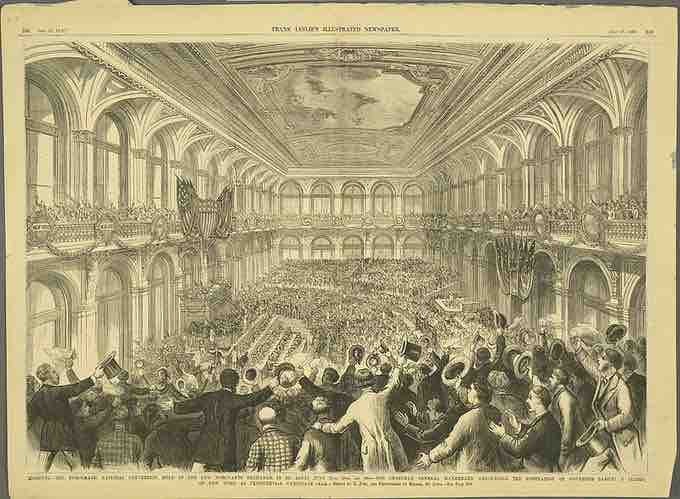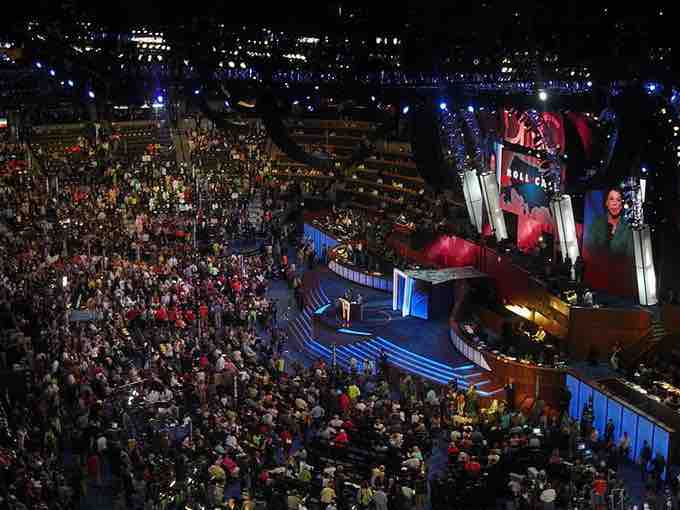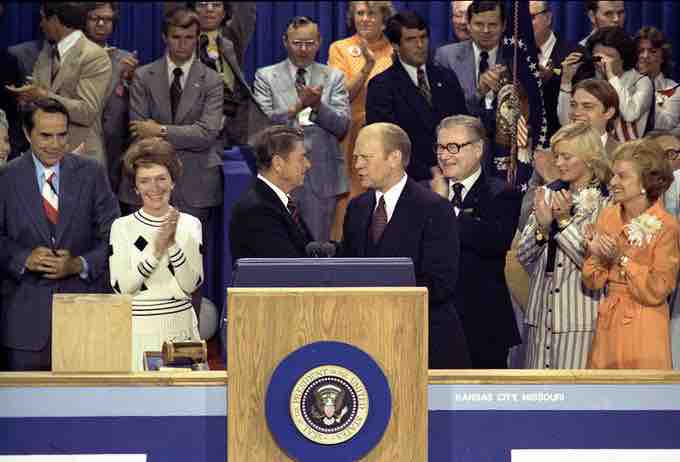Introduction
A United States presidential nominating convention is a political convention held every four years in the United States by most of the political parties who will be fielding nominees in the upcoming U.S. presidential election. The formal purpose of such a convention is to select the party's nominee for President, as well as to adopt a statement of party principles and goals known as the platform and adopt the rules for the party's activities, including the presidential nominating process for the next election cycle . Due to changes in election laws, the primary and caucus calendar, and the manner in which political campaigns are run, conventions since the latter half of the 20th century have virtually abdicated their original roles, and are today mostly ceremonial affairs.

1876 Democratic National Convention
The 1876 Democratic National Convention at the Merchants Exchange Building in St. Louis, Missouri.
Generally, usage of "presidential nominating convention" refers to the two major parties' quadrennial events: the Democratic National Convention and the Republican National Convention . Some minor parties also select their nominees by convention, including the Green Party, Socialist Party USA, Libertarian Party, Constitution Party, and Reform Party USA.

Roll Call DNC 2008
Roll call of states during the 2008 Democratic National Convention.
Logistics
From the point of view of the parties, the convention cycle begins with the Call to Convention. Usually issued about 18 months in advance, the Call is an invitation from the national party to the state and territory parties to convene to select a presidential nominee. It also sets out the number of delegates to be awarded to each, as well as the rules for the nomination process.
Each party sets its own rules for the participation and format of the convention. Broadly speaking, each U.S. state and territory party is apportioned a select number of voting representatives, individually known as delegates and collectively as the delegation. Each party uses its own formula for determining the size of each delegation, factoring in such considerations as population, proportion of that state's Congressional representatives or state government officials who are members of the party, and the state's voting patterns in previous presidential elections. The selection of individual delegates and their alternates is also governed by the bylaws of each state party, or in some cases by state law. The 2004Democratic National Convention counted 4,353 delegates and 611 alternates. The 2004 Republican National Convention had 2,509 delegates and 2,344 alternates.
The convention is typically held in a major city selected by the national party organization 18–24 months before the election is to be held. As the two major conventions have grown into large, publicized affairs with significant economic impact, cities today compete vigorously to be awarded host responsibilities, citing their meeting venues, lodging facilities, and entertainment as well as offering economic incentives. Historically, Midwestern cities such as Chicago, Illinois—which since 1860 has held 25 Republican and Democratic Conventions combined, more than any other urban center in the USA—have become the favored hosts.
Proceedings
Each convention produces a statement of principles known as its platform, containing goals and proposals known as planks. Relatively little of a party platform is even proposed as public policy. Much of the language is generic, while other sections are narrowly written to appeal to factions or interest groups within the party . Since the 1970s, voting has for the most part been perfunctory; the selection of the major parties' nominees have rarely been in doubt, so a single ballot has always been sufficient. Each delegation announces its vote tallies, usually accompanied with some boosterism of their state or territory. The delegation may pass, nominally to retally their delegates' preferences, but often to allow a different delegation to give the leading candidate the honor of casting the majority-making vote.

1976 Republican National Convention
President Gerald Ford, as the Republican nominee, shakes hands with nomination foe Ronald Reagan on the closing night of the 1976 Republican National Convention. Vice-Presidential Candidate Bob Dole is on the far left, then Nancy Reagan, Governor Ronald Reagan is at the center shaking hands with President Gerald Ford, Vice-President Nelson Rockefeller is just to the right of Ford, followed by Susan Ford and First Lady Betty Ford.
The evening's speeches are reserved for major speeches by notable, respected public figures. The speakers at the 2004 Democratic convention included Ted Kennedy, a forty-year veteran of the United States Senate, and Jimmy Carter, a former Democratic President, while at the Republican convention speakers included Governor Arnold Schwarzenegger of California and Governor George Pataki of New York, two of the largest states in the nation.
The final day of the convention usually features the formal acceptance speeches from the nominees for president and vice president. Despite recent controversy maintaining that recent conventions were scripted from beginning to end, and that very little news comes out of the convention, the acceptance speech has always been televised by the networks, because it receives the highest ratings of the convention. In addition, the halls of the convention are packed at this time, with many party loyalists sneaking in. Afterwards, balloons are usually dropped and the delegates celebrate the nomination.